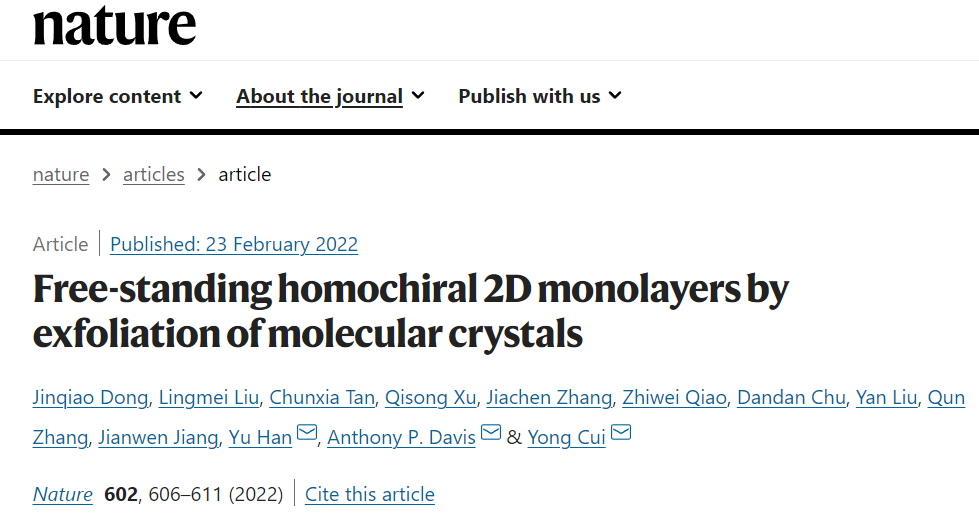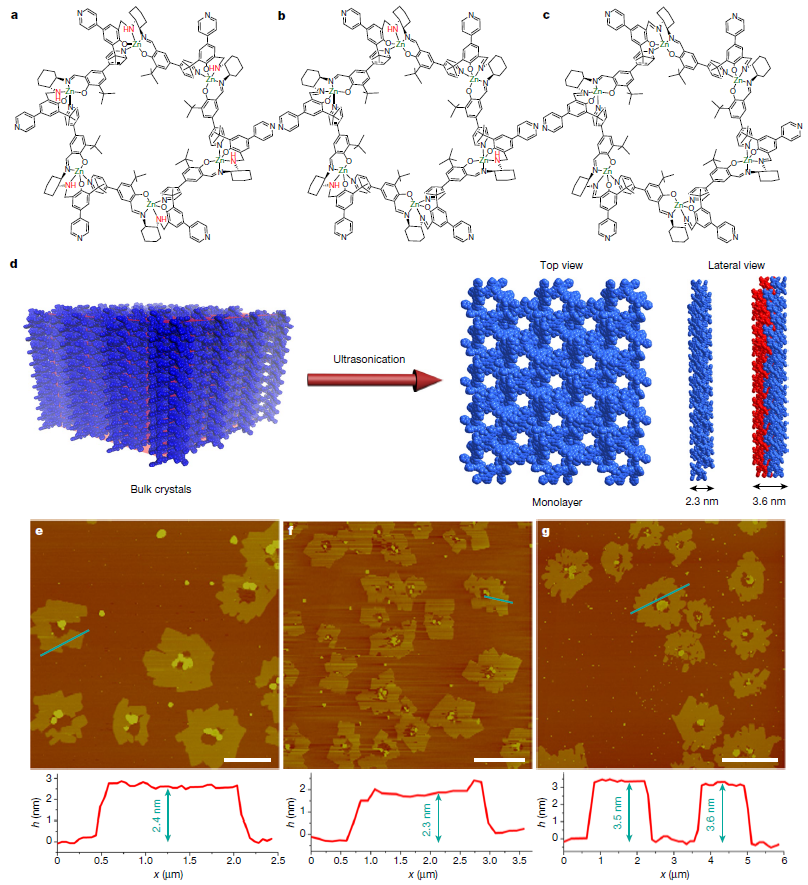
On February 24, 2022, the top international academic journal Nature posted the research result of Prof. Yong CUI's group and co-workers "Free-standing homochiral 2D monolayers by exfoliation of molecular crystals". School of Chemistry and Chemical Engineering, Frontiers Science Center for Transformative Molecules and State Key Laboratory of Metal Matrix Composites, Shanghai Jiao Tong University(SJTU), are the first completers. Associate Prof. Jinqiao DONG from SJTU is the first author. Prof. Lingmei LIU from Chongqing University is the co-first author. Prof. Yong CUI from SJTU, Prof. Anthony P. Davis from University of Bristol, and Prof. Yu HAN from King Abdullah University of Science and Technology are the co-corresponding authors. Prof. Jianwen JIANG from National University of Singapore and Prof. Qun ZHANG from University of Science and Technology of China contributed to the molecular dynamics simulations and ultrafast spectroscopy experiments, respectively.

Since graphene was reported in 2004, monolayer two-dimensional (2D) materials have attracted great attention in the fields of chemistry, physics and materials because of their ultrathin sheet morphology, large exposure of active sites and easy processing. Structurally, strong covalent, ionic or coordination bonds between atoms or molecules are required to support a stable 2D structure, and the weak forces of supramolecular chemistry have been considered insufficient to support the formation of 2D monolayer structure. The research on chiral materials is important for advancing the fields of catalytic science, separation technology, optoelectronics and biomedicine. The lack of methods and characterization means to construct multi-level surface micro-nano structures at the supramolecular level has severely limited the understanding and regulation of chiral recognition and transfer in materials, thus exploring the preparation, structure and properties of chiral 2D molecular materials with monolayer thickness is a new way to break this scientific bottleneck.

Fig.1: Top-down fabrication and atom force microscopy images of chiral 2D monolayer nanosheets of supramolecular metallacycles.
Accordingly, the researchers proposed the strategy of exfoliating macrocyclic molecular crystals and successfully fabricated free-standing chiral 2D monolayers of molecular crystals, and clearly observed the nanostructures of the chiral 2D surfaces. Chiral metal-organic macrocyclic crystals containing abundant chiral binding sites (JACS, 2008, 130, 4582; JACS, 2017, 139, 1554) were ultrasonically exfoliated into chiral 2D monolayer nanosheets with an ultra-high aspect ratio (Fig.1). For the first time, the well-defined supramolecular structures of such six-membered metal-organic macrocycles were clearly observed by using contrast transfer function (CTF) corrected high-resolution transmission electron microscopy (HR-TEM) (Fig.2). It was also confirmed that the as-exfoliated molecular nanosheets can be held together by weak non-covalent interactions, thus exhibiting free-standing properties. Furthermore, enantioselective recognition of the chiral 2D nanosheets towards carbohydrates (such as glucose) shows improved binding and enantiodiscrimination compared to individual metallocycles, presumably resulting from cooperatively generated binding sites.

Fig.2: CTF-corrected HR-TEM imaging of chiral 2D monolayer nanosheets.
This research combines the three frontiers of chiral chemistry, supramolecular chemistry and 2D materials, which confirms the existence of free-standing monolayered 2D molecular crystals and clarifies the chiral expression process across differing length scales. This study also expands the current chiral materials and 2D materials, laying the foundation for future research and applications.
This work was financially supported by the National Science Foundation of China, the National Key Basic Research Program of China, and the Shanghai Rising-Star Program.
Link to the article: https://www.nature.com/articles/s41586-022-04407-8
Link to the highlights of this research: https://www.nature.com/articles/d41586-022-00466-z
Translator: Chenyun SUN
Address:800 Dongchuan RD. Minhang District, Shanghai, China
PostCode:200240 Tel:021-54742893 E-mail:sjtuscce@sjtu.edu.cn

Copyright@ 2023. All rights reserved. Powered by SCCE ICP:2010917